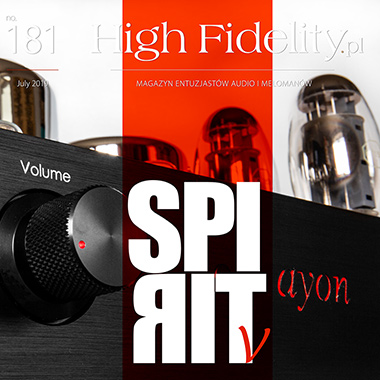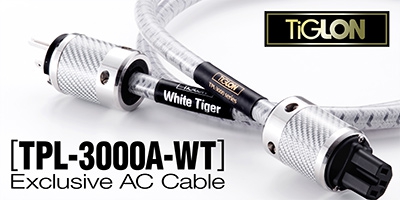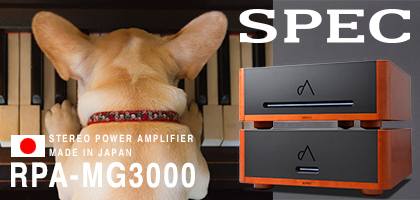No. 257 October 2025
- COVER REVIEW: ANCIENT AUDIO Silver Grand Mono Mk II ⸜ power amplifier • monoblocks » POLAND • Kraków
- KRAKOW SONIC SOCIETY № 153: 30 years of ANCIENT AUDIO » POLAND • Kraków
- FEATURE ⸜ music & technology: HISAO NATSUME presents - In search for the lost great pianism Chopin tradition » part 2 (France) » JAPAN • Tokyo
- REVIEW: AUDIOPHONIQUE Classic AP 300D ⸜ power amplifier » POLAND • Pruszków
- REVIEW: AVATAR AUDIO Holophony No. 1 ⸜ loudspeakers • floor-standing » POLAND • Osowicze
- REVIEW: DIVALDI Gold PA One ⸜ integrated amplifier » POLAND • Kraków
- REVIEW: J.SIKORA Aspire ⸜ turntable (deck + tonearm) » POLAND • Lublin
- REVIEW: MB AUDIO CABLE Silver ⸜ analog interconnect ⸜ RCA » POLAND • Turza Śląska
- REVIEW: XACT N1 ⸜ LAN switch » POLAND • Wrocław


|

|
|
Who needs CLASS D anyway?
| INTRODUCTION – a bit of organoleptic history

Secondly – there was only a relatively small gap in performance level while the price difference was huge. Of course, there are some very good and usually very expensive classic designs, but there is always a matter of affordability. It is always worth spending some time looking for options, because it may turn out that there are other solutions offering a similar performance level, while being more affordable for a bigger potential buyers group of music lovers. Based not on cheaper elements and enforced simplifications, but on a different idea, enabling less expensive, but not necessarily worse, technical implementation. At the time I was using a 300B SET and loudspeakers using Lowther drivers. However, I began to search for a proper amplification for the new Venus Picolla Zeta Zero loudspeakers - these require a lot of current to fully spread their wings. Based on my own auditions during the Show and reviews read in the "High Fidelity" magazine I contacted the owner of Audiomatus company, Mr. Andrzej Matusiak. The first contact with Mr. Andrzej turned into quite a serious email exchange regarding topics related to audio devices. As a result of this exchange, I received answers to many questions and explanations of numerous details, eg regarding proper speaker cables for this type of amplifiers, and I also decided to purchase the AS500 power amplifier from this manufacturer. A year later or so, Audiomatus introduced the AM700 monoblocks, based on the slightly modified modules of the new Bang & Olufsen series - which I purchased and I have been using to this day with great satisfaction. | Here and now, or how the Class D power amplifiers sound like (based on my experience with Audiomatus Products) One could say that the transition from an 8-watt 300B tube amplifier to a Class D one with several hundred watts output is crazy. But I would like to say that it is not, at least for my ears. There are more similarities in these two solutions than differences. The main difference is the efficiency and output of the Class D - in most cases it will offer quite a headroom. Unlike with classic designs, if we push the amp into clipping, the Bang & Olufsen modules will temporarily "flatten" the output signal and we will hear that the flattened dynamics that will let us know we should reduce output. There will be no distortion of high frequencies, which often lead to mechanical and thermal damage to the coils / diaphragms of the tweeters. But it is definitely not easy to push such amplifiers so hard the clipping begins, believe me, I've tried. 
First of all, it's worth repeating once more that the Class D power amplifiers are, most often, with a few exceptions, analog amplifiers receiving and processing an analog signal. In other words - each change of the analog input signal - changes the output signal. There is no "stepping" here, or limitation of possible levels as during PCM signal processing. To be precise, it should be noted that there are very few companies producing digital Class D amplifiers, but in such solutions, one provides a digital signal to the input, and if it is still analog, it is processed by A/D converters. 
If you're interested in this topic you will find an elaborate description and principle of operation of Class D power amplifiers at easy-soft.net.pl. Timbre, saturation, richness - these are the strengths of the Class D. The bass control is also very good. There is no lack of power here and the range is very coherent. The bass is energetic, when needed quickly and effectively stopped. The lowest notes are only slightly less controlled compared to the higher frequencies. The midrange, for me, is simply wonderful. That's where I find Class D to have a lot in common with the sound of a good tube amplifier. |
The vocals are colorful, detailed and strong, but without exaggeration, without dominating the performance. The treble range captivates me with its purity and proper balance with other subranges. They are not aggressive but strong if necessary. Comparing their sound to the one I remember (300b) - they are delivered with more energy. They are not presented as one spot, but rather as the accumulation of many components. In my opinion, after overcoming the problems of the Class D technology's beginning, the designs of amplifiers and power amplifiers operating in the Class D, are more and more refined and worth attention. A few years ago such designs were already introduced by several major companies, eg Jeff Rowland 501 monoblocks. | Organoleptics continued – OLTRE A few days ago I received a phone call from Mr. Tomasz Rogula, the owner of Zeta Zero with an invitation to the Polish pre-premiere private presentation of a new Class D power amplifier. Do you remember the Opera Only amplifier presented at the AVS 2017? This is the work of Italian designer Andrea Pivetta. Let me just remind you that it weighs 1500 kg and costs millions of zlotys. There were only a few units of this amplifier made so far and it should be treated as a reference device showcasing technology available today and the highest engineering skills and top sound quality. As Adam Mokrzycki put it, the AVS organizer: "It's Bugatti Chiron of the world of audio" (more HERE). Andrea Pivetta prepared a new design, this time in Class D. I immediately confirmed my participation for the Friday evening listening session. From what I learned, the new power amplifier should be more affordable for a wider group of potential recipients. The approximate price I found on the internet is about 8,000 euros. Andrea Pivetta is a fan of Mr. Tomek's loudspeakers and they both exchange and rely on opinions from listening sessions. And Mr. Tomasz Rogula sometimes comes up with an idea that some components should be assessed by someone from outside the world of professional audio who could just share his or her impressions - this time it was to be me. 
What can I say - it's hard to remain indifferent while seeing and listening to this amplifier. The visual design itself is original and at the same time it retains minimalism and elegance - but it is an Italian product, so you can expect it to some extent, even by analogy to auto industry, let alone audio one. The chassis - good quality aluminum in beautiful, deep black color. Unlike most other power amplifiers, due to its shape this one will strongly present also cables connected to it. The power inlets are also quite unusual due to the high current output. Hence the idea that the cabling should be provided by a specialized company that will first of all provide cables of appropriate, high performance, but will also pay attention to the aesthetic features. In the pictures you can see the cables prepared for this device by Audiomica Laboratory. Its owner, Mr. Łukasz Mika – also present during our listening session, told me that to develop a proper set of cables for such system designers must take into consideration various factors and requirements that these cables must meet. To reconcile them all and combine them into a functional whole that will show advantages of the power amplifier to their full extend, will not spoil anything and will also look seductive - this is not an easy job. Mr Łukasz "dots an I" through attention to details. Wooden cable boxes visible in the pictures are perfectly made and captivate attention with deep black surface finish and elegance. | SOUND Wide and deep soundstage, precise location of phantom images. Instruments appeared here and now in space. They were placed behind the speakers, on the sides, in the front, there was a very plastic sound space with no clear boundaries. The speakers absolutely disappeared from the room and they seemed to have nothing to do with the fact that there was sound coming from somewhere. Andrea Bocelli sang for us and there it was, the pure magic, an amazing expression in his voice. The timbre of the voice, its saturation and emotions were almost perfectly conveyed. Generally speaking, this power amplifier presents music with sort of inner peace, consistency and specific smoothness. The placement of sound sources placed deeper in the stage was particularly convincing - here the Audiomica Laboratories cables did a great job. The Class D was not particularly convincing in this respect before, and this time it was quite good! The power amps are capable of delivering hundreds of watts per channel and it I could clearly feel it. Composure and huge headroom - no nervousness at higher volume levels. Very good bass control down to the lowest notes. In my opinion it is also important that the listening session was conducted in typically home conditions, without special acoustic treatment of the room, in a spacious living room. 
It was a short listening session so I can't offer an in depth assessment and I just wanted to let you know that Class D is really worth your attention, especially if you own demanding, difficult to drive loudspeakers that require good control and high current output. This is, in my opinion, an already mature technology, which is becoming more and more viable alternative to both classic transistor amplifiers and tube designs. In regards of energy efficiency it clearly beats the other designs, so it lets you save some money, and at the same time it is a pro-environment solution. I'd like to thank Mr. Tomasz for the invitation. onlycreative.it About author I'm 49 years old. I've listened to music since my early childhood. The Radio Three Charts and Grundig cassette player - that was IT! Then, my own speaker designs featuring Tonsil drivers, Aria reel-to-reel tape recorder, Daniel turntable. Another revelation years later - Technics. What a sound! Currently, I am constantly modifying the audio system, which can always be improved, to more accurately present the beauty of music and emotions hidden inside it. I have been a reader of the "High Fidelity" magazine for many years and a regular visitor to the subsequent Audio (Video) Shows. |
About Us |
We cooperate |
Patrons |
|
Our reviewers regularly contribute to “Enjoy the Music.com”, “Positive-Feedback.com”, “HiFiStatement.net” and “Hi-Fi Choice & Home Cinema. Edycja Polska” . "High Fidelity" is a monthly magazine dedicated to high quality sound. It has been published since May 1st, 2004. Up until October 2008, the magazine was called "High Fidelity OnLine", but since November 2008 it has been registered under the new title. "High Fidelity" is an online magazine, i.e. it is only published on the web. For the last few years it has been published both in Polish and in English. Thanks to our English section, the magazine has now a worldwide reach - statistics show that we have readers from almost every country in the world. Once a year, we prepare a printed edition of one of reviews published online. This unique, limited collector's edition is given to the visitors of the Audio Show in Warsaw, Poland, held in November of each year. For years, "High Fidelity" has been cooperating with other audio magazines, including “Enjoy the Music.com” and “Positive-Feedback.com” in the U.S. and “HiFiStatement.net” in Germany. Our reviews have also been published by “6moons.com”. You can contact any of our contributors by clicking his email address on our CONTACT page. |
 



|
   |
main page | archive | contact | kts
© 2009 HighFidelity, design by PikselStudio,
projektowanie stron www: Indecity







 few years ago, after the
few years ago, after the 


